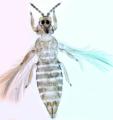Baileyothrips arizonensis
Recognition data
Distinguishing features
Both sexes fully winged. Body and legs yellow with faint shadings, distal antennal segments darkest, wings pale. Head and pronotum with no prominent setae. Head with 3 pairs of minute ocellar setae, pair III on anterior margins of triangle; 2 pairs of minute postocellar setae. Antennae 8-segmented, III–IV with small forked sensorium. Metanotum reticulate, median setae small and far back from anterior margin. Fore wing first vein with 4 or 5 widely spaced small setae on distal half, second vein with 8 to 10 small setae; marginal cilia not wavy. Abdominal tergites II–VII with posteromarginal craspedum that is toothed laterally, median setae longer than the distance between their bases; tergite VIII with posteromarginal comb of fine microtrichia; IX with median setae shorter than submedian pair. Sternites IV–VI with about 8 small marginal setae, also 8–10 small discal setae.
Male sternite III with glandular opening medially on antecostal region.
Related and similar species
Only two species are recognized in this genus. The second one, B. limbatus (Hood), is known from various parts of the Caribbean area in association with the weed Chamaesyce hyssopifolia (Euphorbiaceae) (Mound & Marullo, 1996).
Taxonomic data
Current valid name
Baileyothrips arizonensis (Morgan)
Original name and synonyms
- Anaphothrips arizonensis Morgan, 1913: 12
- Anaphothrips minutus Moulton, 1929: 127
Family placement
Thripidae, Thripinae
Biological data
Life history
Presumably flower-living
Host plants
Possibly a species of Euphorbia (Euphorbiaceae).
Tospoviruses vectored
None
Crop damage
None
Distribution data
Area of origin
Western USA
Distribution
California, Arizona, New Mexico, Texas.








